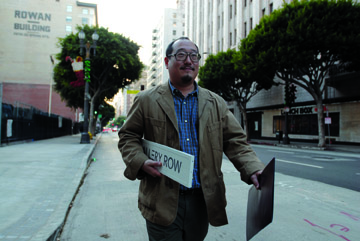By Jimmy Lee Photographs by Eric Sueyoshi
Twas fifteen nights before Christmas, and all throughout buildings in downtown, the creatures of L.A.’s nightlife were stirring, perhaps even the mice. Some 50 people carrying boomboxes blaring composer Phil Kline’s “Unsilent Night” strolled down the avenues, like a moving sound sculpture. Women danced in a vacant storefront at 5th and Spring, their colorful costumes illuminated as if beacons. At the Hive Gallery, a go-go dancer perched on a ledge shimmied to a deejay’s throbbing musical mixes, as people below jostled to get a better view of the paintings, photographs and other art forms lining the walls.
These were a few scenes from last month’s Downtown Art Walk, a popular event taking place mostly along Main and Spring streets, the primary arteries of what’s became known as Gallery Row. After four years, this assemblage of art and activity has helped to revitalize a section of downtown that was formerly part of skid row.
One of the community activists behind this dramatic transformation is Nic Cha Kim. He, along with co-founders Kjell Hagen, Kimba Rogers and Cheyanne Sauter, had a dream in 2004 to have several blocks of downtown designated “Gallery Row,” even though only three galleries stood there at the time. Give a vision a name and work to realize it—that would be their approach.
“It’s a difficult thing to convince people to risk their shirts in an area synonymous with skid row,” said Kim, 35, of those early days. “But if the circumstances and the price are right, then anything is possible. We met with building owners, gave tours to prospective creative business owners and produced art and cultural events throughout the year.”
By the end of the first year, three galleries became nine. Now there are more than 30. The event with the biggest impact has been the monthly Downtown Art Walk, started nine months after Gallery Row was established. While the inaugural gathering may have attracted only a few hundred walkers, Kim estimated, an average of 10,000 people now stop in to the neighborhood’s galleries, shops and restaurants on the second Thursday of every month.
“Now it’s just out of control,” said a very pleased Nathan Cartwright, who opened Hive Gallery on Spring Street more than four years ago.
“I really mean it when I say thank you. [Downtown Art Walk] is probably the best thing going on in the city,” said Los Angeles City Councilwoman Jan Perry, at a Dec. 10 ceremony to celebrate Gallery Row’s fifth anniversary. Perry was instrumental in passing the legislation to designate the area, which is located in her district.
On this special day, Kim, a playwright who has a day job as an assistant at the Walt Disney Co., cheerfully escorted a few friends around, despite the threat of heavy rain. After a short rest at Kim’s own gallery, Niche, he was soon buying more artwork to help cover the walls of his apartment, as well as introducing his guests to an artist who combines Disney characters with bawdy cartoons from old Playboy magazines. Emily Robertson, a teenager from Australia visiting family, bought a few pieces.
Throughout the night, locals approached Kim and congratulated him.
“[Kim and the Gallery Row founders] are the lifeblood of this stuff,” said Tom Gilmore, a real estate developer largely responsible for the revival of loft housing downtown. “I mean developers can’t do this. You can’t invent creativity.”
The consequences of success, however, can be even broader, especially for local stakeholders. For Gilmore, Gallery Row has made downtown a place where people want to live—just what the owner of several residential buildings could want. And Councilwoman Perry can take credit for cleaning up this area of skid row, especially if she runs for mayor in 2013, as some media outlets have speculated.
But the growth has not come without its share of problems. The growing fleet of food trucks in Los Angeles are staking out more and more sidewalk space on art walk nights. That’s taking business away from restaurants, whose owners are not happy. Those initially apprehensive about the row’s development include low-income housing advocates, who feared that the gentrification occurring with loft conversions would worsen. Instead, Kim said Gallery Row has led to unexpected new opportunities, citing Michael Blaze and the Skid Row Photo Club.
“Blaze procures donated digital cameras, distributes them to skid row residents, leads free weekly photography classes and arranges for printing and framing [prints], which all culminates into an art show for everybody,” Kim described. “If you can activate skid row residents to appreciate and participate in art by giving them a camera, imagine what is possible if you gave them a job. I know it’s not that simple, but you can’t tell me we made it worse.”
He added, “The thing about community activism is you never stop getting criticized. When Gallery Row first emerged, it was, ‘How is it a row? There are only three galleries.’ Now we have 35, but now people complain it’s too crowded.”
Kim does not let the criticism faze him, and instead focuses on making downtown a more vibrant neighborhood through the arts. It’s a vision he shares with others. “The art walk and the galleries … here are engines for creativity,” said Gilmore. “And finally the city gets to be a city, a real city, where it’s incredibly diverse in terms of the demographics and the people who come here, and that live and work here.”






